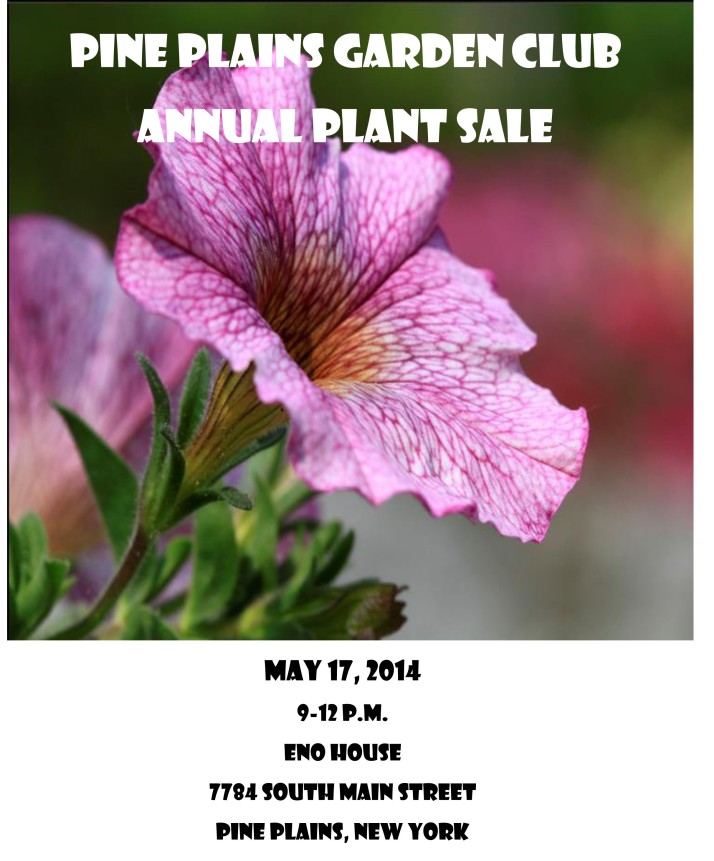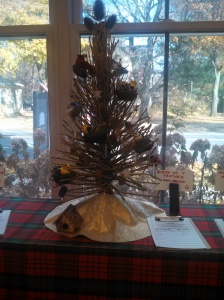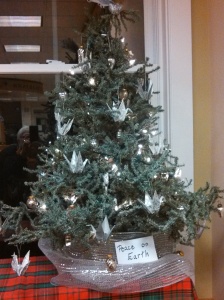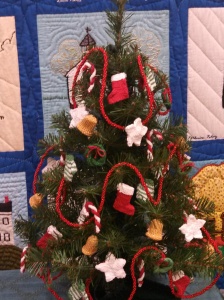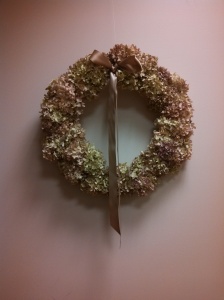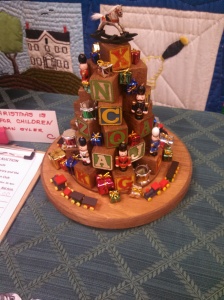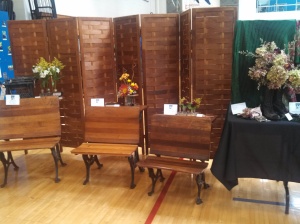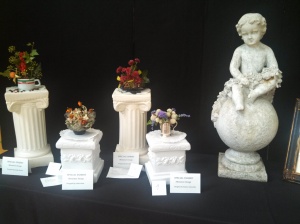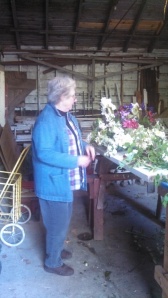2014 Activities and Programs
It’s a busy year for the Pine Plains Garden Club:
March 20: Sunprint/Cyanotype
April 10: Spring Luncheon @ Uncle Sonny’s, Stanfordville, NY
April 17: Third District Spring Meeting. Diamond Mills, Saugerties, NY
April 24: 10 a.m. Beach garden cleanup
April 25: National Arbor Day
May 16: 4 p.m. Plant sale setup at Eno House, South Main Street, Pine Plains, NY. Bring plant donations for sale in containers. Please identify plants.
May 17: 9-12 p.m. Annual Plant Sale. Eno House, South Main Street, Pine Plains.
May 22: 10 a.m. Window boxes, town barrels
May 24: 9 a.m. Cemetery planting
May 26: 7 a.m. Memorial Day sprays. Rae Hart’s house
May 26: 3 p.m. Tree dedication to honor Janet Adams and Fran Bradley. Town Beach
June 5: 10 a.m. Meet at Town parking lot. Stonecrop Gardens. 81 Stonecrop Lane, Cold Spring, NY. $5. Guests Welcome.
June 19: The Climbery. 201 Buckwheat Bridge Rd. Livingston, NY. 12:30 p.m. meet at Town parking lot. Guests Welcome.
July 10: 10 a.m. Falls Village Nursery. Meet at Town parking lot
July 24: 10 a.m. Alice Platt Gardens. East Taghkanic. Meet at Town parking lot
August 7: 12:30 p.m. Rae Hart’s home at Stissing Lake. Bring a covered dish. Flower sow final discussions, plant exchange.
September 4: 12:30 p.m. Mary Briggs Sanctuary. Underwater design workshop
October 9: 2:30 p.m. FFA Fall Festival/ Flower Show. Setup with team. 4 p.m. arrangements can be brought in. Stissing Mountain Middle/High School
October 10: 9 a.m. – 6 p.m. FFA exhibit
October 11: 11 a.m. – 3 p.m. FFA exhibit
October 16: Third District fall meeting
November 6: 11 a.m. Plant town window boxes
November 8 – 29. Festival of Trees. November 29, 4 p.m. auction ends
December 4: 10 a.m. Christmas workshop. Assemble winter sprays. Guests Welcome
Join us for our 2014 Plant Sale
Keeping Up With the Web
Take A Byte is a column written by Jan Sillik. It’s devoted to reviews of websites, with recommendations for those of interest for National Garden Clubs members.
flowermag.com . . . with a slogan of “enriching life through flowers.” Offers a feast of beautiful decorative floral design photos for a variety of seasons and occasions. NGC partners with Flower Magazine, and you’ll want to subscribe to the magazine for future enjoyment, and there is a digital magazine.
crownbees.com “Your complete Mason Bee Resource.” This comprehensive site is filled with information, Tips and Helps, Videos, Supply information, online shopping and lovely photos. Click on the NGC tab to learn more about the NGC BeeGap Overview and Roles, the NGC Speakers Bureau, and sections on Education and Fundraising. Pollinators are crucial for our food supply and this site will explain why NGC is encouraging us to get involved with this essential project.
nybg.org . . . news and information from the New York Botanical Garden. As they state it, “for budding floral designers, recreational gardeners and aspiring landscape designers.” One of the outstanding sites on the web with a wealth of information about an American botanical garden treasure.
rootstoblooms.com . . . adventures in eco-friendly floral design, gardening, nature and photography. There’s even information on “Green Mechanics” for floral design. One tip found there is, “When your flowers fade, don’t forget to compost them.” A recommended magazine on this site is the “Green Scene”, the magazine of the Pennsylvania Horticultural Society. The PHS sponsors The Philadelphia Flower Show.
2013 Festival of Trees
The Pine Plains Garden Club and Pine Plains Library are sponsoring a Festival of Trees Silent Auction November 2-30th during Library hours. Winning bids will be announced November 30th before the town Parade of Lights. Check out these beautiful entries!
2013 Flower Show – “Flowers For Every Room” (more rooms)
2013 Flower Show “Flowers For Every Room”
Rhinebeck Garden Club Upcoming Event
We are always happy to share information about other gardening clubs. Wednesday, September 25, at SUNY Ulster Campus, Stoneridge, NY. The Rhinebeck Garden Club will meet at 10 a.m. at the Xeriscape Garden for a tour led by a master gardener from the Cornell Cooperative Extension of Ulster County. Guests are welcome, $5 fee. For information on this event, contact Brenda Brockett at 914-475-3502.
Bus Trip to New York City
Cornell Cooperative Extension of Ulster County’s Master Gardener program is sponsoring a bus trip Sept. 26 to the High Line Park in New York City with shopping at the Chelsea Market Concourse. The park is built on a historic freight rail line elevated above the streets on Manhattan’s West Side. Bus departs 8 a.m. from MAC Fitness parking lot in the Kingston Plaza and returns at 7:15 p.m. Cost is $35 per person. Registration deadline is Sept. 20. 845-340-3990. www.cceulster.org
Planting at the Pine Plains Town Beach
Some Secret and Not So Secret Gardens
Friends of Taconic State Park. 518 966 2730. Supporting the activities of the Taconic State Park. Copake Falls, NY. Promoting recreational, historic, educational and cultural activities. Advocating for the maintenance and improvement of its facilities and programs becoming a voice for the park by acting as a liaison with governmental bodies, institutions, schools, businesses, regional groups and their organizations of common concern.
- June 8. Take a “Walk on the Wild Side.” Botanist and northeast wildflower authority, Robert Naczi, of the NY Botanical Garden, leads a wildflower walk in Taconic State Park. Info: 518 966 2730.
- July 25. 5th Annual meeting and potluck supper at Copake Iron Works. 6 p.m. Details to be announced.
- September 22. Hidden Valley Hike with Hudson Valley Ramble. Details to be announced.
Stonecrop Gardens. Cold Spring, NY. 845 265 2000. Open Monday – Saturday. 10-5. www.stonecrop.org. Consists of 12 acres of gardens at a windswept elevation of 1,100 in the Hudson Highlands. See a diverse collection of plants conservatory, enclosed flower garden, woodland garden, Mediterranean garden, alpine rock ledge. Guided group tours available. Plus “Open Days” June 23, July 21, August 18, September 15, October 13. Join them for tea in the garden noon-4 p.m.
The Beatrix Ferrand Garden at Bellefield. Hyde Park, NY. www.beatrixfarrendgarden.org. Free. 7 days/wk. 7 a.m. – sundown. Closed Thanksgiving, Christmas, New Years. 4097 Albany Post Road, Route 9. Hyde Park.
Weathersfield. 214 Pugsley Hill Road. Amenia, NY. Sunday, June 30. Part of Garden Conservancy’s open days program. 10 acres of formal classical style and outer gardens surround Chauncey Stillman’s Georgian style brick house. Garden open 10-4. Garden tours at 11 a.m. and 2 p.m. House open for viewing 12-2. Admission $5. http://www.weathersfieldgarden.org.
Bard College. Blithewood Road. Red Hook, NY. 845 758 7179. http://inside.bard.edu. Blithewood Garden. Turn of the century Italianate walled garden overlooking the Hudson River. The grounds began their metamorphosis from untamed woods into a carefully landscaped estate in the late 1830s and Andrew Jackson Downing was commissioned to design the grounds. Open seasonally, May-November.
Hudson River mansions, Innisfree, Vassar College – Arboretum and Shakespeare Garden.
Garden Club of Amenia, Ltd. Lecture series.
- June 15. 2 p.m. Roses, with a viewing of two local rose gardens. Presenter: Paul Arcario. All lectures held 3rd Saturday of the month 2-4 at Amenia Town Hall, Route 22. Amenia, NY. Free.
Hidden Gardens of Amenia. Saturday, July 13. As many as 15 gardens. Keep your eyes open for when tickets go on sale.
Horticulture Magazine. Features “Gardeners on the Go.” http://hortmag.com/subscribe/gardeners-on-the-go. Great gardening ideas, time saving tips and garden travel inspiration.
GardenersHub.com. Free weekly smart gardening e-news letter. Packed with timely tips and plant recommendations, plus quick links to great deals.
Whiteflower Farm. Litchfield, CT. Open 9-5:30. 860 567 8789. June 22. 9-5. Open house. Iced tea and cucumber sandwiches on the lawn. Serving at 2:30. The display gardens should be close to peak and the Begonia House will be hitting its stride. More info whiteflowerfarm.com/events.
Florence Griswold Museum. Historic gardens and grounds of Miss Florence’s boardinghouse for artists. Delight in the landscape made famous by the Lyme Art Colony. FlorenceGriswoldMuseum.org. 96 Lyme St., Old Lyme, CT. off exit 70 of I95. 860 434 5542.
Stamford Museum and Nature Center. www.stamfordmuseum.org. Stamford, CT. 118 acres include trails, 300 ft. boardwalk for strollers or wheelchairs. A garden with plants indigenous to CT at entrance of the boardwalk. Property includes flowers, shrubs, trees, groundcovers, as well as a lake, waterfall, fountain, sculpture, and farm with organic flower and vegetable garden.
Hollister House Garden. 300 Nettleton Hollow Road. 860 868 2200. Group tours contact hollisterhousegarden.org. Set against an historic CT farmhouse, this romantic country garden juxtaposes exuberant plantings with formal lines of the 20th century English gardens that inspired its owner George Schoelikopf and is noted for its subtle and sometimes surprising color combinations. High walls and hedges divide the garden into series of rooms that open onto interesting vistas. Several areas of this Garden Conservancy Preservation Project have been recently revised and expanded to include a kitchen garden and hillside paths.
Berkshire Botanical Garden. 5 West Stockbridge Road. Stockbridge, MA 01262. 413 298 3926.
- June 8. 4 p.m. Tasting Terroir: A Story of Earth, Wine and Human Hope. Wine tasting, book signing and sale to follow talk.
- June 15. At Home in a Potager Garden.
- June 20. 10:30-12:30 p.m. Native Knowledge. Learning about native plants at Nasami Farm.
- July 8-29. 10-1. The Garden in Watercolors, Session I. En Plein Air Watercolor Painting In the Summer Garden.
- July 11. 10-12. Collecting Woody Plants Propagation Workshop.
- July 18. 9:30-12:30. Meadow Gardening at Its Very Best.
- August 1 and 2. 10-4. Landscape Painting with John McDonald.
- August 5-26. 10-1. The Garden in Watercolor, Session II. En Plein Air Watercolor Painting in the Summer Garden.
- August 7. 4 p.m. Private Edens: Beautiful Country Gardens. Book sale and signing to follow lecture.
- August 15. 10-5. Standing Stones in the Garden Stone-Carving Workshop. Tools and materials provided. Bring bagged lunch, safety goggles and dress for working.
- August 22. 10:30-12:30. Seed saving in your New England Garden.
- August 22 and 23. 10-4. Botanical Painting with Watercolor. Master class with Carol Woodin
- October 5 and 6. 10-5. Fall in the Berkshires at its very best. Live music, crafts, food, rides, silent auction, plant sale, tag sale, farmers market, fun for the kids.
- See their web site for other events added throughout the year.
Area Nurseries Share Their Knowledge
Wards Nursery and Garden Center. 600 South Main Street; Great Barrington, MA. 413 528 0166.
Hosting designers continuously until Mid-September.
- Craig Okerstrom-Lang Design. May 30-June 9.
- Pat Parkins Gardens of the Goddess. June 13-June 24.
- Eloise Richman Passion Flower Landscape Design. June 27-July 8.
Helpful information from Wards
- Time to fertilize. All your gardens could use a light dose of 10-10-10 Epsoma Garden Food as they begin to grow. This is a fast feed that last only 4 weeks. After that, fertilize with a slow release season long fertilizer.
- Watch for frost warnings. Cover tender annuals and vegetables with spun polyester like material. A light frost will not kill your perennials or spring bulbs. Zone 5 frost free date is May 22.
- Prevent crabgrass organically with gluten weed preventer.
- Apply dormant oil spray to prevent fungus spores and insect pests on any susceptible woody plants before leaf buds open. Choose a day when 24 hours of dry weather above 40 degrees is forecasted and calm for spraying.
- Bird feeders should be brought inside at night to avoid black bear visits. Encourage birds into your yard with birdhouses and hummingbird feeders.
Phantom Gardener. 6837 Route 9, Rhinebeck NY. 876 8606.
Workshops and events throughout the year.
2013 Memorial Day
Pictures From Our Gardens
2013 Memorial Day Planting
Garden Conservancy “Open Days”
More Musings from Mary. . . . . .
“Open Days” – Private gardens participate in “Open Days”. The Garden Conservancy’s book lists the dates and locations of these gardens, as to when the public can visit them. The cost is $5.
Since 1995, nearly 3,000 private gardens have participated in Open Days, welcoming close to one million visitors!
The mission of the conservancy is to preserve exceptional American gardens for the education and enjoyment of the public. The seek to develop and deepen public appreciation of gardens as integral elements of our national artistic and cultural heritage. The Open Days program serves as the primary educational outreach for the Conservancy.
Open Days are almost entirely volunteer driven. More than 50 men and women from California to Maine have organized very special opportunities for you to visit gardens with them. Learn more about the Garden Conservancy’s preservation work, visit their website: www.gardenconservancy.org
Currently, the Garden Conservancy is helping to protect more than 30 gardens across the country. Many of them are historic landmarks.
Open Days
Saturday, June 1st
Connecticut – Hartford County – Canton. The garden of Mary Tomolonius, 10-4. Collinsville. Bill and Penny Dole, 10-4; Riverbend Garden. Kent McCoy, 10-4; Small Pleasures, A. Walter Kendra, 10-4.
New York – Columbia County – Claverack. Peter Beracqua and Stephen King, 10-4. Copake Falls. Margaret Roach, 10-4. Valatie. Kevin Lee Jacobs, 10-4. West Taghkanic. Arcadia. Ronald Wagner and Timothy Van Dam, 10-4.
Sunday, June 2nd
Connecticut – Hartford County – Collinsville. Bill and Penny Doyle, 10-4; Riverbend Garden. Kent McCoy, 10-4. Small Pleasures, A. Walter Kendra, 10-4.
Massachusetts – Berkshire County – Ashley Falls. “Good Dogs Farm” Maria Nation and Roberto Flores, dirtmeisters, 10-4; Housatonic. Under the Hemlocks, 10-4.
Pressed Flowers
Submitted by Mary Briggs
Nearly everyone has saved a flower or leaf by pressing it between the pages of a book. Pressing flowers has been a favorite art form since it gained popularity during the Victorian Age. Various methods have been tried and used since then. The method of using a telephone book (absorbent paper-can’t use glossy paper), and then place heavier books on top of the phone book works well-and is free. It takes a few weeks for the flower to dry; and flowers can stay in the book for years and still be o.k. There are other methods. Make your own wooden press or buy one, use your microwave-but this is time consuming. You can also go online for more information.
Drying Your Own Flowers
This article was submitted by Mary Briggs
You don’t need a large area to grow enough plants for several dried floral arrangements. Plan your garden so you can enjoy it year around by planting evergreens like boxwood, deciduous plants, annuals and perennials. You can also plant rows of flowers in your vegetable garden, too. Herbs are easy to grow and can be planted in flower beds, pots, window boxes, plant containers, etc. They transform simple cooking into gourmet dishes. They make lovely bouquets that delicately scent a room. When dried in bundles or crushed and put into a shallow dish – all these too delicately scent a room, especially when placed in the sun. They can be made into a wreath or an arrangement.
You can usually find a wide selection of weeds, grains, seed-heads and pods in craft stores. By drying your own focal flowers such as hydrangeas, zinnias, roses, dahlias, and sunflowers; and a selection of line flowers such as larkspur, delphiniums and liatris, you can save money and have a greater variety of flowers in your arrangements.
Harvesting – Successful drying depends not only upon the preserving process, but also upon picking the plants at the right time. Cut the flowers in the early A.M. or late P.M. At these times the flowers are fully saturated with water. Enjoy cut roses as they open. Just before they reach full bloom, remove them from the water and hang them upside-down to dry. Delphiniums, larkspur, foxglove, and lupine should be gathered when the lower buds are flowering, but the very top ones are still closed.
Select as near perfect a flower as possible. Cut the flower when the heads feel firm.
Air Drying
There are several air-drying methods used to accommodate all the different kinds of floral material. The easiest and most effective way to dry most flowers is to tie them in small bundles with twine, raffia or ribbons, and hang them upside down, out of direct sunlight in a warm, well-ventilated place – like a closet, for example.
Bunches should contain one type of flower. Dry large flowers individually – like hydrangea. Strip the leaves as soon as possible after picking. They retain moisture and slow down the drying process. Stagger bundles or individual flowers to allow plenty of air to circulate. This prevents mildew and rot. Warmth, protection from direct sunlight, a dry atmosphere and plenty of ventilation provide the best results. It may be necessary to re-tie the bundles or individual flowers half way through the drying process because the stems tend to shrink as they dry.
The drying period can range from one week to several depending on the type of material, when and where the flowers were harvested and the humidity. The stems of hung flowers tend to dry unnaturally straight and become brittle, handle gently.
Spray the dried flowers with hair spray or an aerosol floral sealer to help prevent shedding and shattering. Grasses, moss, lichen, bamboo and leafy branches dry well when laid flat on an absorbent surface like cardboard, newspaper or paper towels. Whole branches of ferns, braken, and spiky leaves can also be dried this way
example: Arrange material in a single layer on several layers of newspaper. Don’t overlap the material. The leaves will shrink a little, but they will retain much of their original color and shape on the stalk/stem; which they will not do if they are hung upside down or dried upright.
To dry upright, for heavy headed plant material. Take a cardboard box and make a shelf of coarse gauge chicken wire or use floral netting. Or make a grid using string, using quilter’s pins or finishing nails or brads to anchor the string on the top sides of the box, make several horizontal rows of string; then repeat going vertical. Each plant stem has a home in a square. Be sure to provide a deep enough box so the stem can hang freely.
Many ornamental grasses dry well when they are set upright in a container with a small opening, allowing them to bend slightly and naturally. Materials that break easily after they are dried such as: heather, pussy willows, statice and boxwood, etc. can be arranged while they are fresh and left to dry in the arrangement.
Oven drying: Compact flowers like marigolds, cornflowers, chrysanthemums, zinnias, etc. dry well in a fan-assisted, convection oven. Non-ventilated ovens are not appropriate, because they generate too much moisture.
The material must be dried at a very low temp around 100 degrees, over many hours. The flowers are slotted through holes in a wire mesh rack leaving room for the stems to dangle below. The time required depends upon density of the flowers. Check often to make sure the oven does not get too hot!
Drying in Sand: Use children’s play sand, no chemicals. It takes flowers and foliage, about three weeks to dry in sand. To prepare tall, spiky flowers like delphinium, pour an inch of and in a large flat container (like a clean cat litter box). Scoop out a place for each flower and build up the sand around it. Pour the sand in a circular motion around the flower. To prepare round, compact flowers like zinnias, wire the stems (insert a thin floral wire into the stem), and place them upside down in an inch of sand. Build up the sand on top, by pouring sand around the edges of the flowers it just supports the natural form of the flowers until dry. The sandboxes can be placed in the sun, attic, or any other warm and dry location. Flowers can be left indefinitely in sand, because sand is inert and won’t affect the flowers. Silica gel draws moisture out of the flowers so you have to time them more carefully. To speed up the drying, place the sandbox in a 100 degree oven or let the natural heat from the pilot light (I you’ve a gas oven) extract moisture.
Drying with Desiccants: Although drying with desiccants, such as a silica gel or a mixture of borax and cornmeal, can be the least predictable way to preserve flowers and foliage, the results can be dazzling and lifelike. The desiccant must be completely dry before you begin. Warm it in a 100 degree oven for half-hour before using. Most compact flowers dry best with their heads facing up when using desiccants. Wire the stems before drying. Bend the wires out of the way as necessary. Lay delphiniums and other spiky flowers lengthwise onto the desiccant. Dry one type of flower at a time because some flowers take longer to dry than others.
Layer an inch or so of silica gel or an equal mixture of borax and cornmeal on the bottom of a large flat container. Plastic storage boxes with tightly fitting lids are perfect. Build up the desiccant around the edges of the flowers. Sprinkle a light layer on top of each flower. Separate the petals carefully with a toothpick as you sprinkle. Build up the layer on top until it’s one inch deep. Cover the container with a tight fitting lid and store in a dry place. Check in four or five days to see if the flowers are papery and dry. If not, re-cover with desiccant, close the lid and check again in a couple of days. If they are left too long, they become brittle and dark. So, check often. When dry, slowly pour the desiccant through your hands, catching each flower and testing to make sure it is papery and dry. Use a soft brush (artist paint brush) to remove any desiccant that tends to cling.
Microwave Drying: Herbs can be successfully dried in the microwave and stored for future use. Cut perfect leaves and remove any foreign material. Don’t prewash. Place on a paper towel, don’t overlap, and heat on medium high for one minute. If still moist, change the paper towel, and repeat the process until herbs are dry. Allow the herbs to ‘rest’ for ten minutes – in between cooking. Wait until the herbs are room temp before storing in a tightly covered container.
Storing Dried Flowers and Foliage: The safest way is in a long, shallow cardboard box. Poke holes in the sides and tops to let the air circulate. Add small packets of desiccants to absorb moisture. Wrap your dried bundles of flowers in tissue paper, and lay them in a head and foot arrangement. Don’t overcrowd. Label the box and store where the temp is relatively constant.



